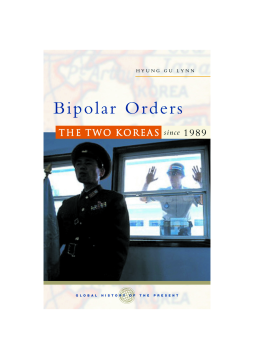
Additional Information
Book Details
Abstract
North Korea and South Korea are never far from the news headlines - one for the alleged danger it poses to the world, the other for its apparent capitalist success story. In Bipolar Orders, Hyung Gu Lynn analyzes the processes driving both countries since the 1980s.
North Korea has experienced severe economic deterioration and increasing international isolation, while South Korea has undergone democratization and witnessed the emergence of a vibrant consumer culture. Paradoxically, this growing gap in ideologies and material standards has led to improved relations between the two countries. Why has this counterintuitive development occurred? Is North Korea really a threat, and if so, for whom? This book provides a substantive, accessible, and timely examination of the complex and compelling histories of the two Koreas.
Hyung Gu Lynn is the AECL/KECPO Chair in Korean Research at the University of British Columbia. He has researched and taught at universities in Canada, the USA, South Korea, and Japan. His current research projects range from economic history to contemporary popular culture, plastic surgery to epistemology.
'Lynn's book is a rich and elegant tour de force that both informs and challenges conventional perspectives on the two Koreas on multiple levels, from politics to popular culture, and re-affirms the importance of understanding the present and future of the divided peninsula in the context of its deeply-textured past. Among the plethora of recent books on Korea, this is one that truly stands out-a "must-read" for anyone interested in contemporary Korea, professional and layman alike.'
Carter J. Eckert, Yoon Se Young Professor of Korean History, Harvard University
'This book reflects the diversity of the author's long experiences on the Korean Peninsula and gives a vivid sense of the great variety of people that inhabit North and South Korea. It is an effective and dynamic work that argues that there is no "end of history" for the two Koreas.'
Tae Gyun Park, Seoul National University
'Hyung Gu Lynn has written a concise, well-judged and most useful analysis of the Korean peninsula since the fall of the Berlin Wall. South Korea’s continuing democratization and development toward the 10th-ranking industrial power of the world, combined with North Korea’s unexpected persistence since 1989, both raise important questions about the 'end of history' narrative.'
Bruce Cumings, University of Chicago
'This book will serve as a good introductory analysis to the complexity of the post-1989 Korean arena for Asian studies, political science and even economics students, as well as for policy makes who strive to understand what is happening in the Korean Peninsula.'
Alon Levkowitz, Tel-Aviv University, Pacific Affairs
Table of Contents
| Section Title | Page | Action | Price |
|---|---|---|---|
| Cover | cover | ||
| Title page | iii | ||
| Table of Contents | v | ||
| Acknowledgments | vi | ||
| Acronyms | vii | ||
| Notes on Transliteration | ix | ||
| Map of the Korean Peninsula | xi | ||
| Chronology | xii | ||
| Introduction | 1 | ||
| The Significance of the Two Koreas | 3 | ||
| Objectives | 12 | ||
| Background History | 14 | ||
| 1 | Pandora’s Box? | 23 | ||
| Democratization: 1960—1987 | 26 | ||
| Democratic Consolidation: 1987—2002 | 38 | ||
| New Trends in Democracy | 44 | ||
| Conclusion | 54 | ||
| 2 | Altered States | 56 | ||
| Economic Development, 1960—97 | 58 | ||
| 1997 Financial Crisis and Recovery | 64 | ||
| Demographic Change | 82 | ||
| Conclusion | 89 | ||
| 3 | Holy Trinity | 91 | ||
| Analytical Approaches | 94 | ||
| Holy Trinity | 97 | ||
| The Father | 98 | ||
| The Spirit | 104 | ||
| The Son | 109 | ||
| The Second Ascension | 116 | ||
| Conclusion | 122 | ||
| 4 | Economic Tetralogies | 124 | ||
| The Four Economies | 127 | ||
| Threat? | 143 | ||
| Reforms | 149 | ||
| 5 | Decussation Effects? | 154 | ||
| “Anti-Americanism” | 155 | ||
| Inter-Korean Relations | 157 | ||
| Defectors | 164 | ||
| Decussation Effects? | 167 | ||
| Conclusion | 170 | ||
| 6 | Conclusion | 172 | ||
| Notes | 177 | ||
| Introduction | 177 | ||
| Chapter 1 | 179 | ||
| Chapter 2 | 182 | ||
| Chapter 3 | 186 | ||
| Chapter 4 | 189 | ||
| Chapter 5 | 192 | ||
| Suggestions for Further Reading | 195 | ||
| Index | 200 |
